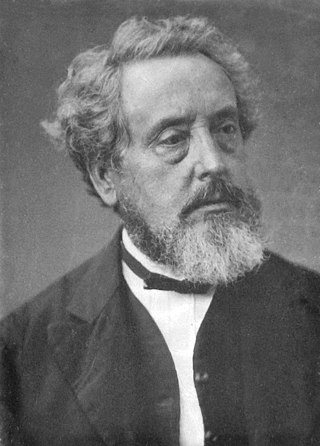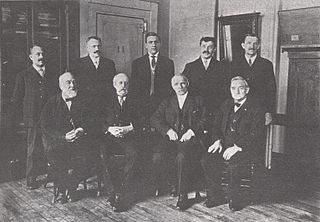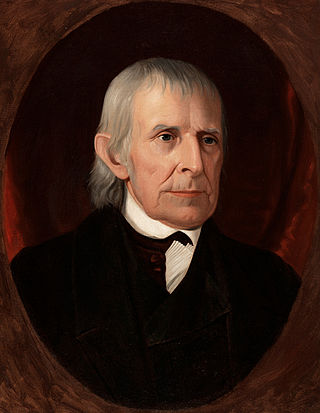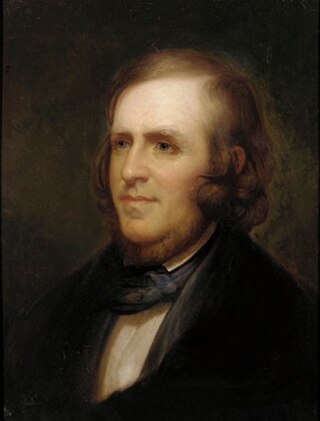
The Franklin half dollar is a coin that was struck by the United States Mint from 1948 to 1963. The fifty-cent piece pictures Founding Father Benjamin Franklin on the obverse and the Liberty Bell on the reverse. A small eagle was placed to the right of the bell to fulfill the legal requirement that half dollars depict the figure of an eagle. Produced in 90 percent silver with a reeded edge, the coin was struck at the Philadelphia, Denver, and San Francisco mints.
Robert Scot (October 2, 1745 – November 3, 1823) was a Scottish-American engraver who served as Chief Engraver of the United States Mint from 1793 until his death in 1823. He was succeeded by William Kneass. Scot designed the popular and rare Flowing Hair dollar coinage along with the Liberty Cap half cent. Scot is perhaps best known for his design, the Draped Bust, which was used on many silver and copper coins. Robert Scot was the most prolific engraver of early American patriotic iconography, with symbols and images depicting rebellion, unity, victory, and liberty throughout his career in America.

Christian Gobrecht was the third Chief Engraver of the United States Mint from 1840 until his death in 1844. He was responsible for designing the famous "Seated Liberty" designs, which were in turn the direct inspiration for the design of the Trade Dollar. He designed the Gobrecht Dollar, which was struck in small quantities from 1836 to 1838 and later inspired the Flying Eagle cent. He also designed the obverse sides for the Liberty head Quarter Eagle, Half Eagle, and Eagle gold coins, as well as the "braided hair" type Half cent and Large cent coins.

William Barber was Chief Engraver of the United States Mint from 1869 until his death in 1879. He succeeded James B. Longacre in the position.

Charles Edward Barber was an American coin engraver who served as the sixth chief engraver of the United States Mint from 1879 until his death in 1917. He had a long and fruitful career in coinage, designing most of the coins produced at the mint during his time as chief engraver. He did full coin designs, and he designed about 30 medals in his lifetime. The Barber coinage were named after him. In addition, Barber designed a number of commemorative coins, some in partnership with assistant engraver George T. Morgan. For the popular Columbian half dollar, and the Panama-Pacific half dollar and quarter eagle, Barber designed the obverse and Morgan the reverse. Barber also designed the 1883 coins for the Kingdom of Hawaii, and also Cuban coinage of 1915. Barber's design on the Cuba 5 centavo coin remained in use until 1961.

The Seated Liberty dollar was a dollar coin struck by the United States Mint from 1840 to 1873 and designed by its chief engraver, Christian Gobrecht. It was the last silver coin of that denomination to be struck before passage of the Coinage Act of 1873, which temporarily ended production of the silver dollar for American commerce. The coin's obverse is based on that of the Gobrecht dollar, which had been minted experimentally from 1836 to 1839. However, the soaring eagle used on the reverse of the Gobrecht dollar was not used; instead, the United States Mint (Mint) used a heraldic eagle, based on a design by late Mint Chief Engraver John Reich first utilized on coins in 1807.

The Gobrecht dollar, minted from 1836 to 1839, was the first silver dollar struck for circulation by the United States Mint after production of that denomination had been halted in 1806. The coin was struck in small numbers to determine whether the reintroduced silver dollar would be well received by the public.
Frank Gasparro was the tenth Chief Engraver of the United States Mint, holding this position from February 23, 1965, to January 16, 1981. Before that, he was Assistant Engraver. He designed both sides of the Susan B. Anthony dollar, both sides of the Eisenhower Dollar, the Lincoln Memorial reverse of the cent, and the reverse of the Kennedy half dollar.

William Kneass was the second Chief Engraver of the United States Mint from 1824 until his death in 1840. Kneass is credited with designing the "Classic Head" motif, which appeared on numerous denominations of American currency, including the gold quarter eagle ($2.50) and half eagle ($5.00) gold pieces from 1834 to 1839. He also modified John Reich's "Capped Bust" design for use on the half dime through half-dollar from 1829 to 1837.

George Thomas Morgan was a United States Mint engraver who is famous for designing many popular coins, such as the Morgan dollar, the reverse of the Columbian Exposition half dollar, and the reverse of the McKinley Birthplace Memorial gold dollar.

Joseph Saxton was an American inventor, watchmaker, machinist, and photographer from Pennsylvania. A daguerrotype taken by Saxton in 1839 is one of the oldest surviving photographs taken in the United States.

The gold dollar or gold one-dollar piece is a gold coin that was struck as a regular issue by the United States Bureau of the Mint from 1849 to 1889. The coin had three types over its lifetime, all designed by Mint Chief Engraver James B. Longacre. The Type 1 issue has the smallest diameter of any United States coin minted to date.

The Columbian half dollar is a coin issued by the Bureau of the Mint in 1892 and 1893. The first traditional United States commemorative coin, it was issued both to raise funds for the 1893 World's Columbian Exposition and to mark the quadricentennial of the first voyage to the Americas of Christopher Columbus, whose portrait it bears. The Columbian half dollar was the first American coin to depict a historical person.

The Lincoln cent is a one-cent coin that has been struck by the United States Mint since 1909. The obverse or heads side was designed by Victor David Brenner, as was the original reverse, depicting two stalks of wheat. The coin has seen several reverse, or tails, designs and now bears one by Lyndall Bass depicting a Union shield. All coins struck by the United States government with a value of 1⁄100 of a dollar are called cents because the United States has always minted coins using decimals. The penny nickname is a carryover from the coins struck in England, which went to decimals for coins in 1971.

James Barton Longacre was an American portraitist and engraver, and the fourth chief engraver of the United States Mint from 1844 until his death. Longacre is best known for designing the Indian Head cent, which entered commerce in 1859, and for the designs of the Shield nickel, Flying Eagle cent and other coins of the mid-19th century.

John Adam Eckfeldt was a worker and official during the first years of the United States Mint. A lifelong Philadelphian, Eckfeldt served as the second chief coiner of the Mint, from 1814 until 1839.

Joseph Wright was an American portrait painter and sculptor. He painted life portraits of George Washington and Benjamin Franklin, and was a designer of early U.S. coinage. Wright was President Washington's original choice for Chief Engraver of the U.S. Mint, but died at age 37, before being confirmed to that position.

The Liberty Head double eagle or Coronet double eagle is an American twenty-dollar gold piece struck as a pattern coin in 1849, and for commerce from 1850 to 1907. It was designed by Mint of the United States Chief Engraver James B. Longacre.

Benjamin Franklin Peale was an American officer of the Philadelphia Mint from 1833 to 1854. Although Peale introduced many innovations to the Mint of the United States, he was eventually dismissed amid allegations he had used his position for personal gain.

The Roosevelt dime is the current dime, or ten-cent piece, of the United States. Struck by the United States Mint continuously since 1946, it displays President Franklin D. Roosevelt on the obverse and was authorized soon after his death in 1945.

















